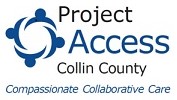Uninsured in Texas
* Highest Rate of Uninsured
* 150,000 Uninsured in Collin County
Stats on the Uninsured
- In 2013, most of the uninsured were in working families but did not have access to or could not afford employer-sponsored coverage.

- Uninsured people are far more likely than those with insurance to report problems getting needed medical care.
- Uninsured people are less likely than those with coverage to receive timely preventive care.
- Because of the cost of care, many uninsured people do not obtain the treatments their health care providers recommend for them.
- Because people without health coverage are less likely than those with insurance to have regular outpatient care, they are more likely to be hospitalized for avoidable health problems and experience declines in their overall health.
- Lack of health coverage, even for short periods of time, results in decreased access to care.
- Research demonstrates that gaining health insurance improves access to health care considerably and diminishes the adverse effects of having been uninsured.
- Public hospitals, community clinics, and local providers that serve disadvantaged communities provide a crucial health care safety net for uninsured people; however, the safety net does not close the access gap for the uninsured.
- Increased demand and limited capacity means safety net providers are unable to meet all of the health needs of the uninsured population.
- According to the Centers for Disease Control and Prevention Texas has the highest rate of persons without health insurance coverage in the United States.
Taken from Kasier Family Foundation – The uninsured: key facts about health insurance and the uninsured in America.
How the Uninsured Affects You
Uncompensated care is important because costs incurred by hospitals in providing this care eventually must be paid by someone. Hospitals are forced to shift these costs to other payers — typically private insurance companies. This is referred to as the “cost shift”.
Uncompensated care and inadequate reimbursement by government insurance programs like Medicare and Medicaid end up affecting everyone because they contribute to the increase in the overall cost of health care.
As the health care bill continues to rise businesses are forced to either reduce benefits to employees or require their employees to pay for a greater portion of their monthly premium. In other words, your premiums will continue to increase along with deductibles and copays.
The Texas Medical Association estimates a condition that could be treated in a doctor’s office using Medicaid rates would be $56.21, including labs and x-ray. That same treatment in an Emergency Room would cost $193.92. Taxpayers, Texans with insurance, and employers who offer health benefits are paying for those uninsured and at a higher rate. The Texas Medical Association also reports it costs Texans more than $116 Billion in 2008.
Why Project Access?
By focusing on prevention/lifestyle changes and treatment at the early signs of an illness, we can control costs and minimize severe health care challenges. Project Access-Collin County services provide a real time alternative to utilizing the local Emergency Department as a means to routine healthcare.
PACC is committed to improving the health of our community by creating access to care and services for those most in need. Our task is to coordinate a network of physician volunteers and other healthcare providers and make it easier to donate medically necessary care to the low-income uninsured in our communities. Through our navigation program, we encourage patients to participate in their own and learn to overcome common barriers to living a healthy and prosperous life. Our Community Advocacy Program is a vital part of our mission and includes services such as: interpretation/translation, basic health education, transportation services and coaching/coordination with connecting clients to local and state resources.

